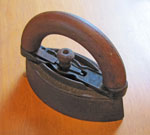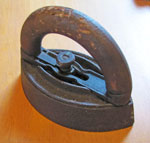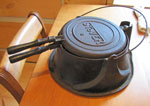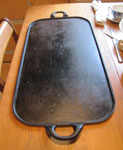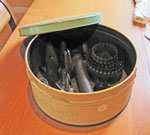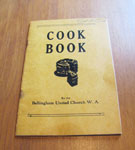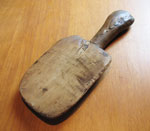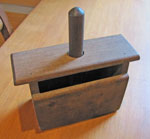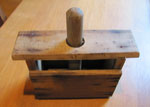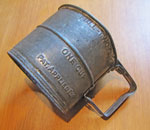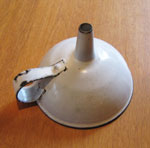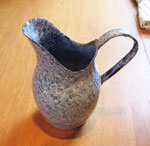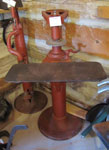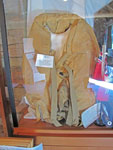Résultats
- This double kitchen cupboard actually appears to be two separate pieces placed together. The top part of the cabinet was painted a light beige color and has two interior shelves. The doors have a recThis double kitchen cupboard actually appears to be two separate pieces placed …
- This was known as a "sad iron" with a detachable handle. These type of irons were not called "sad" irons because in old english sad meant (Heavy, dense, solid) therefore the term. This particular typThis was known as a "sad iron" with a detachable handle. These …
- This was known as a "sad iron" with a detachable handle. These type of irons were not called "sad" irons because in old english sad meant (Heavy, dense, solid) therefore the term. This particular typThis was known as a "sad iron" with a detachable handle. These …
- The handle on this iron is chipped, and gouged.The handle on this iron is chipped, and gouged.
- "Stover" written on Waffle Press"Stover" written on Waffle Press
- This is a large cast iron flat griddle with handles on each end, it is approximately 24 inches long and 15 inches wide. It would have been used on top of an woodstove and would allow the cooking of mThis is a large cast iron flat griddle with handles on each …
- This is a white cotton sugar bag made of feedsack cloth with the writing still faintly visible in blue. There is a blue triangle through which the words Royal Acadia Surag appear. Below is Royal AcadThis is a white cotton sugar bag made of feedsack cloth with …
- This multi-piece set is contained in a large round tin marked "Cookies". The can is a pale yellow color with a green lid. Inside are various icing tips for fancy cake or cookie decorating. There areThis multi-piece set is contained in a large round tin marked "Cookies". …
- Found on George Hendry's farm in Sowerby. Used in the 1920s. This is an A. H. Reid butter worker made in Philadelphia, Pennsylvania. It was originally patented on March 23, 1875 by Alban Reid. The loFound on George Hendry's farm in Sowerby. Used in the 1920s. This …
- This is a small cookbook compiled by the Bellingham United Church Women's Association. It has a yellow cover, white pages, and includes recipies and a number of advertisements for local companies.This is a small cookbook compiled by the Bellingham United Church Women's …
- A wooden spoon like this would have been used for creaming butter on its own or for creaming butter and sugar together when baking.A wooden spoon like this would have been used for creaming butter …
- This is small rectangular wooden box that is made of wood that was used to squeeze the buttermilk out from the butter in the last stages of the process. The press fit inside with the handle extendingThis is small rectangular wooden box that is made of wood that …
- This is small rectangular wooden box that is made of wood that was used to squeeze the buttermilk out from the butter in the last stages of the process. The press fit inside with the handle extendingThis is small rectangular wooden box that is made of wood that …
- This bowl would have been used in the butter making process while trying to get the milk solids to form and would have been used with the large flat wooden butter spoon. From Hugh and Mary (Reed) MonThis bowl would have been used in the butter making process while …
- This is a two cup sifter with writing on the side that indicates there was a Patent applied for on this particular design.This is a two cup sifter with writing on the side that …
- This is a enamelware funnel done in white and was extremeley popular in the early 1900'sThis is a enamelware funnel done in white and was extremeley popular …
- Blue and white enamelware pitcher with rounded handle.Blue and white enamelware pitcher with rounded handle.
- This is a Preston Co. skate sharpener with a horizontal sharpening wheel.This is a Preston Co. skate sharpener with a horizontal sharpening wheel.
- Used in the 1930's at the old Iron Bridge School houseUsed in the 1930's at the old Iron Bridge School house
- he Mae West was a common nickname for the first inflatable life preserver, which was invented in 1928 by Peter Markus (1885–1974) (US Patent 1694714) with his subsequent improvements in 1930 and 1931he Mae West was a common nickname for the first inflatable life …








